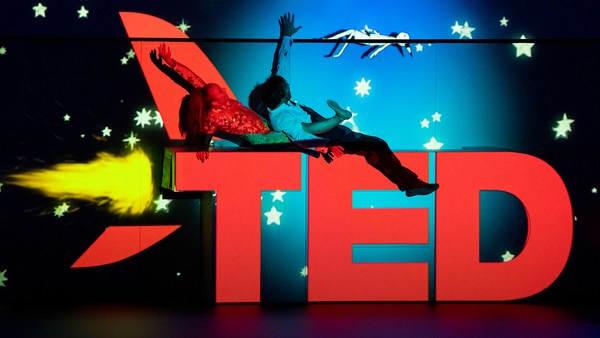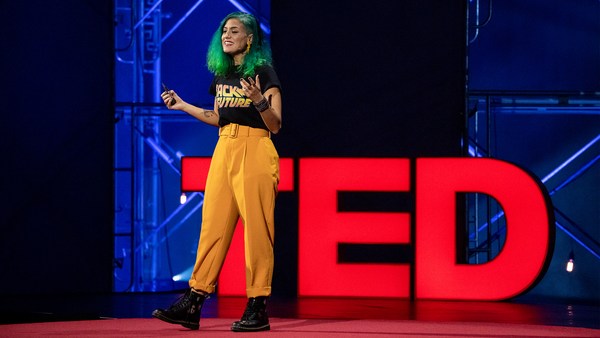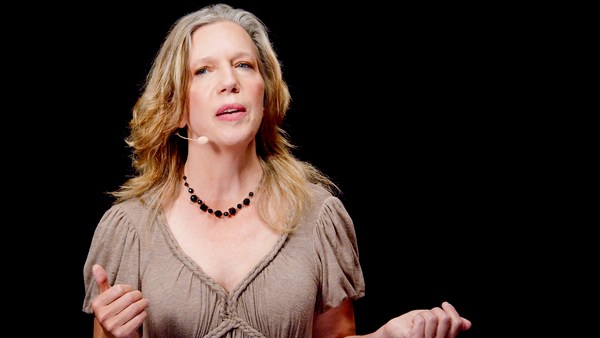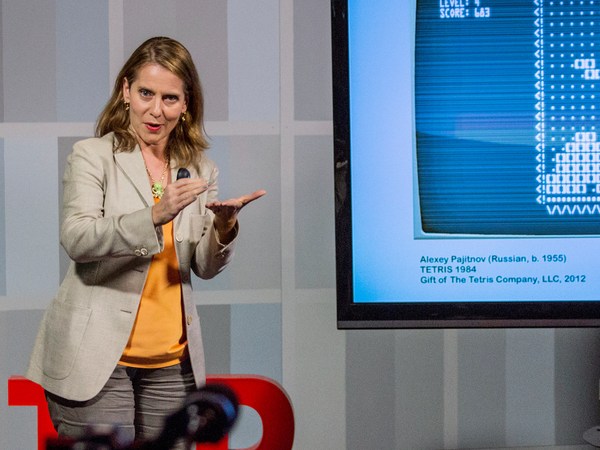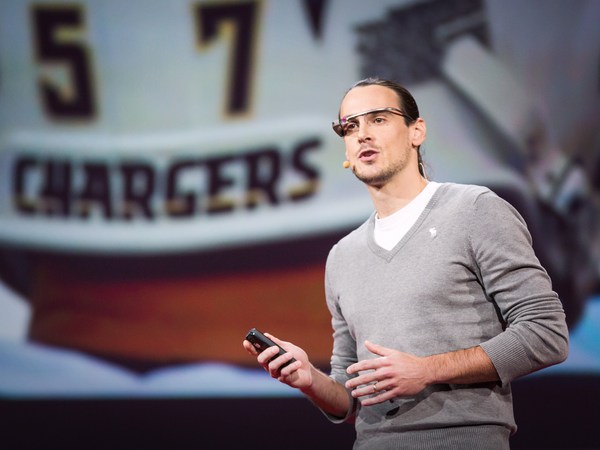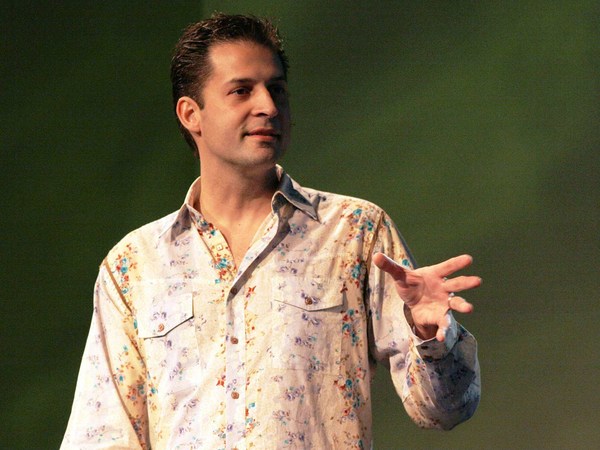Do you remember when we all had to stop the spread and stay at home? Well, I tell you, one of the unexpected, positive things to come out of that time -- well, other than the normalization of comfortable clothing in public, obviously --
(Laughter)
was that my industry, digital art and immersive entertainment, experienced a huge surge of interest. More folks than ever before turned to their screens to seek out digital experiences and online connection and well, social connection in online spaces. We couldn't connect in-person, so suddenly, our digital lives took on a whole new level of importance. This sudden global demand accelerated the research and development of a previously sci-fi concept known as the metaverse. In the metaverse, we will connect with one another as virtual avatars. We will live, work and play together, building a whole new, magical dimension of existence.
(Laughter)
It sounds like a dream, right? Well, technically, it’s a programmer’s nightmare. But if we can pull it off, it will become the world's largest community-driven digital world-building experiment to date.
But we don't want to sit inside staring at our screens anymore. At least I don't. I love my digital art, but I want to take it with me out into the real world. So let's do that.
This is (Never) Lonely Boy. He's sitting in the abandoned lot by himself, until he's surrounded by his virtual friends. Now, what if those virtual friends could join me here on the TED stage?
(Audience cheers)
Oh, bam!
Hey, little buddies. Now, ideally, we'd all be wearing augmented reality glasses, but consumer-ready AR glasses are not quite there yet, but this is kind of cool. But how can we build on this? You know, what's next? And is there a way for the digital experiences that we create to truly enrich our physical lives?
So today I'll propose three pillars, for what I think will help us build a healthy metaverse. Starting off with pillar number one: community. So back in 2010, I had a very enriching experience when I got to collaborate with a bunch of geniuses in the Pilbara desert in northern western Australia. Meet the Love Punks. So we went about our digital world-building in a very analog way. We got dressed up, we put on a face paint, we built sets, and then we brainstormed our stories by acting them out. Now, what blew my mind was how invested these young people became in their digital identities and their digital world-building, that it motivated them to show up every single day, for two years, to learn how to color themselves in the comic and animate themselves in the video game. Now, the Love Punks began as a collaboration with a community of around 40 people and five grandmas. There was -- Grandmas, they were the wildest punks.
(Laughter)
And in Australia, they went on to inspire a live-action TV series and a national curriculum teaching young Australians how to become Love Punks.
(Applause)
It's not bad for a bunch of punks.
So that experience highlighted to me how the digital worlds we build can be a wonderful playground for exploring identity, for learning new skills, for practicing creativity and bringing our communities together.
And that brings us to pillar number two: technology and more specifically, access to technology. We need to ensure everyone can participate in this future metaverse. So around the same time as Love Punks, I began imagining how to scale these digital world-building ideas in my cyberpunk web comic called Nawlz. Now I imagined, like, a future digital culture where the youth had chips in their head that allowed them to project their art and imagination onto a shared digital layer that covered themselves and their city. So like, they could hang out at the club wearing their virtual fashion. Or they could get chased down the street by some crazy digital tentacle things that got pretty weird. That digital culture would be described today as an augmented reality metaverse. Now we're probably not all ready to get chips in our heads, but thankfully we can access augmented reality on our mobile devices.
So one day I received a mysterious comment on that web comic. It read: "We could make some of those things ..." Very mysterious. So I clicked on the user profile and discovered that person was an augmented reality programmer.
So I messaged them back immediately: "Yes" Let's make all the things!!!" That person, Lukasz Karluk is now my business partner, and we augmented everything. Augmented reality comics, augmented reality tattoos, stickers. There's a cute little turtle. Kids could color in their own kites and then fly them immediately as augmented reality kites. I even AI hacked "The New York Times." That was a little controversial.
(Laughter)
We had a lot of artists reaching out to us, asking how we were doing it. So we created tools to allow them to augment their work. And very quickly, we had a community of artists covering the world with their augmented art. It was beautiful. I felt like my vision was finally starting to make some traction. But up until now, all the experiences that I've shared have been standalone. For example, a Love Punk's avatar kind of like step out of the video game and then suddenly appear walking down the street beside you in augmented reality? Like, that digital bridge doesn't exist yet. But what if it did?
And this brings me to my third pillar: decentralization. So for us to move seamlessly through the metaverse, we need for our art and our avatars to be decentralized. We can't be dependent on a single platform. Sorry, Zuck.
(Laughs)
I mean, what if that platform were to die? We don't want to lose our art. So NFTs -- another word that's been flying around a lot lately -- help us to solve this problem. NFTs are unique, decentralized digital assets, and they've also come to represent a new economy that has been widely accepted as the norm for buying and selling digital art. So not only can NFTs move from one platform to the next, but they can be sold and digital artists can get paid. And that all helps to keep the lights on in the metaverse.
So lately I've been kicking the wheels of my own metaverse called the Sutuverse. Very humble. And my first project in the Sutuverse is Neonz. I illustrated hundreds of cyberpunk characteristics like virtual reality headsets and face tattoos and antennas. Then we created a tool to combine all these characteristics together to generate 10,000 unique avatars as NFT artworks. We then put those NFT artworks up on the environmentally friendly Tezos blockchain. Thousands of fellow cyberpunk enthusiasts collected them. Thank you. We then connected our augmented reality app to that blockchain to allow our community to become their Neonz in AR. And look at us. We're like a cyberpunk Brady Bunch. And just imagine again, when we have those augmented reality glasses and we can just see each other down the pub like this, like, that'll be one hell of a Neonz reunion. If you're not interested in the theatrics of putting Neonz on your face, that's cool. Because you can also put your Neonz floating out there in the physical world. So there's some Neonz down in the snow, Neonz down the beach, Neonz floating above an oblivious cat. And if you're not interested in the Neonz aesthetic, that's fine, too, because soon you'll be able to put any digital art you've created or collected floating out there in the physical world.
So I feel like our Love Punks community and our Neonz community are totally ready for this future. But how are you folks feeling?
(Cheers)
Are you ready for this brave new digital world?
(Audience murmurs)
Not sure? Well, this is just the beginning. You could leave a digital artwork on the street corner for your lover to find. You could reinvent your backyard with an animated treasure hunt for your kids and their friends. We could use this tool to simply cover the world. Or we could use it to further connect us to this world. I'm interested in the latter. How can we use this powerful tool to create an augmented reality metaverse that truly enriches our physical lives?
Thank you.
(Applause and cheers)
